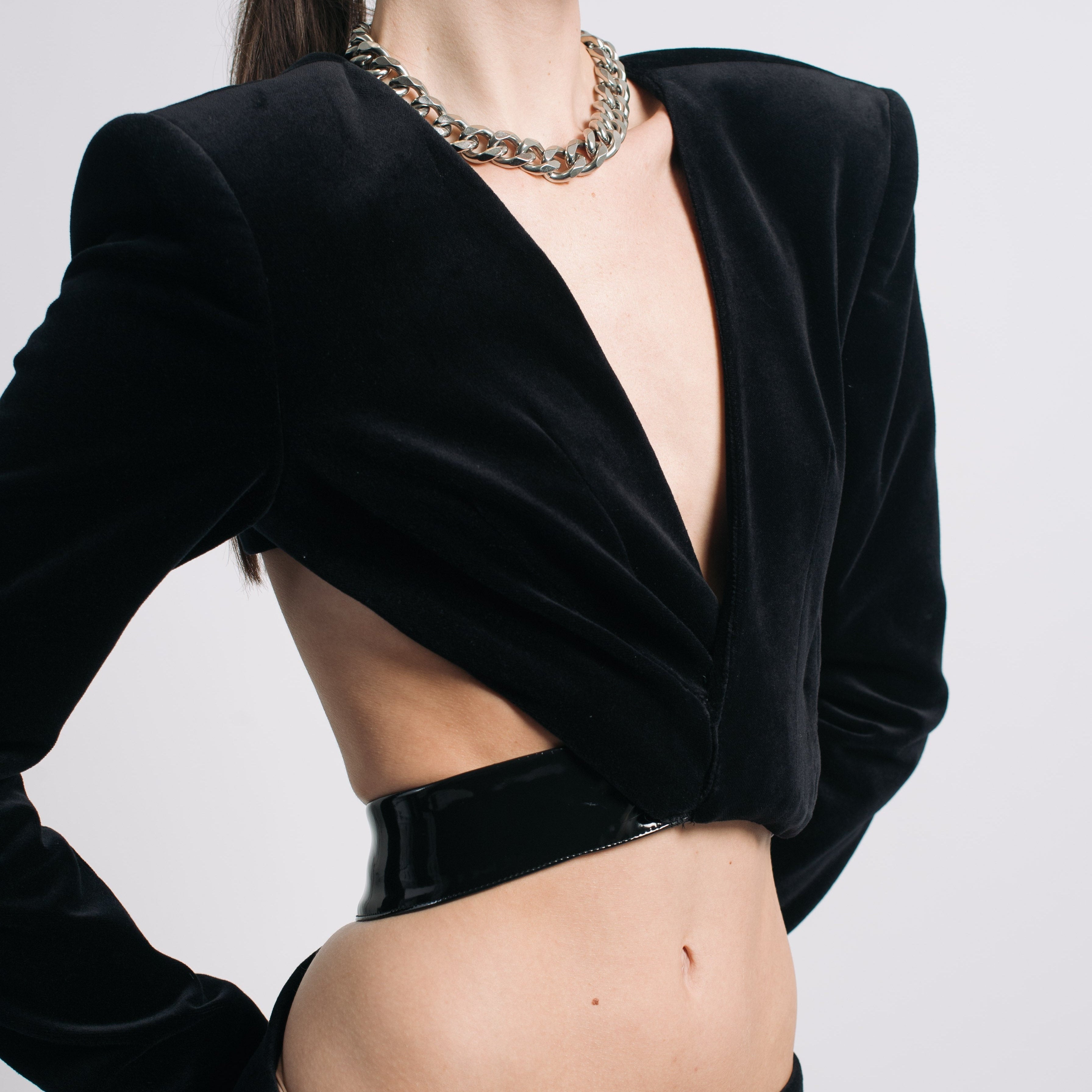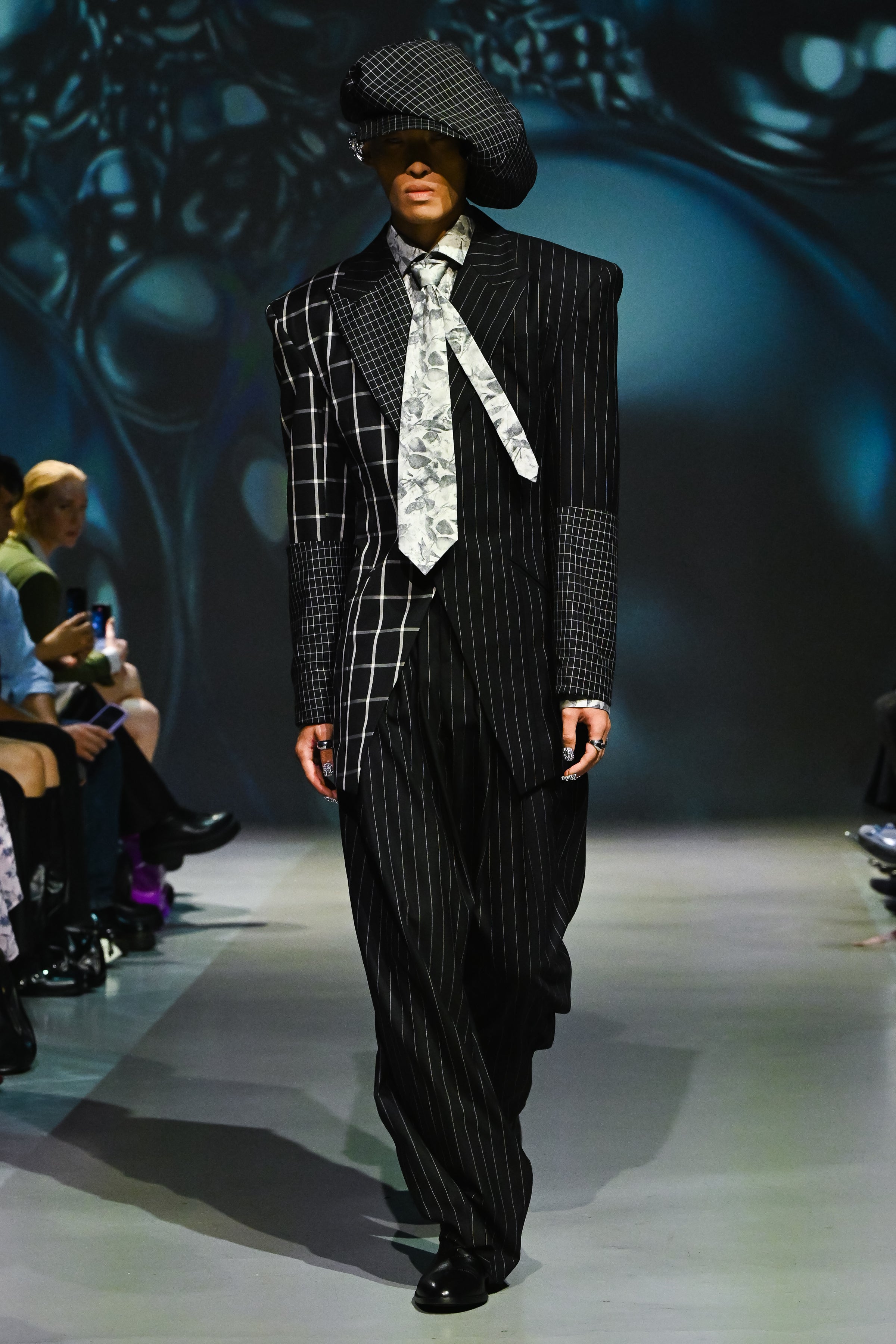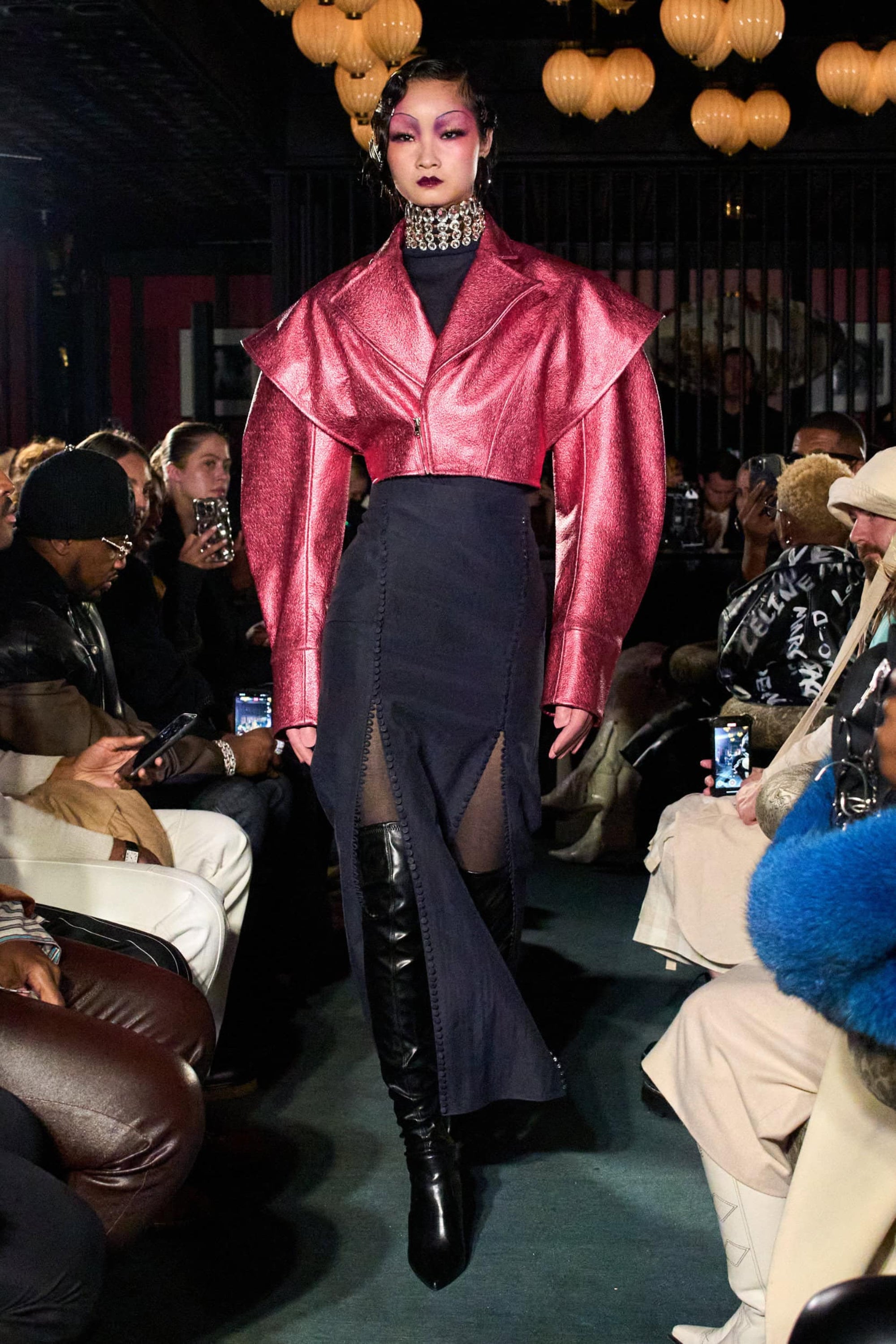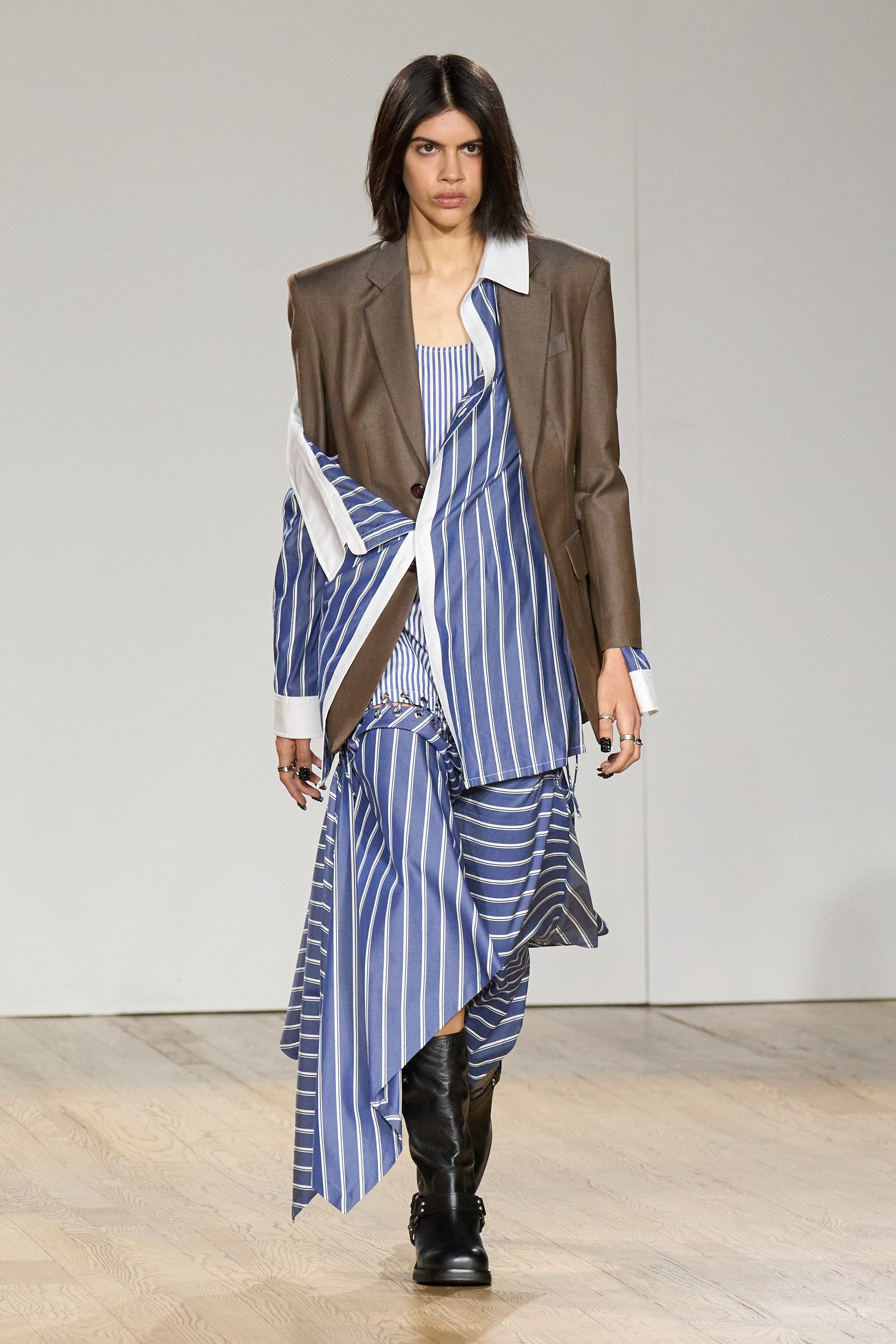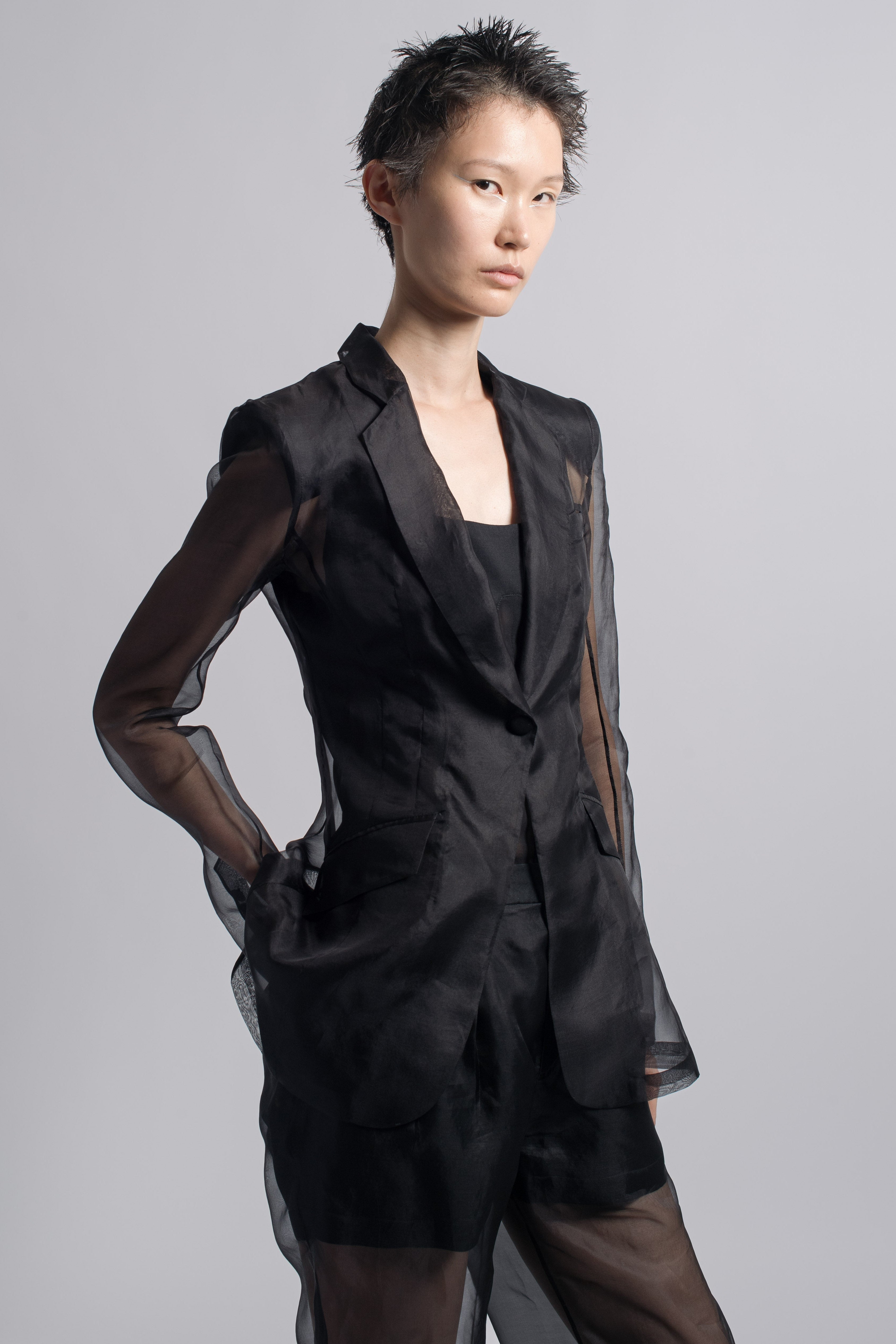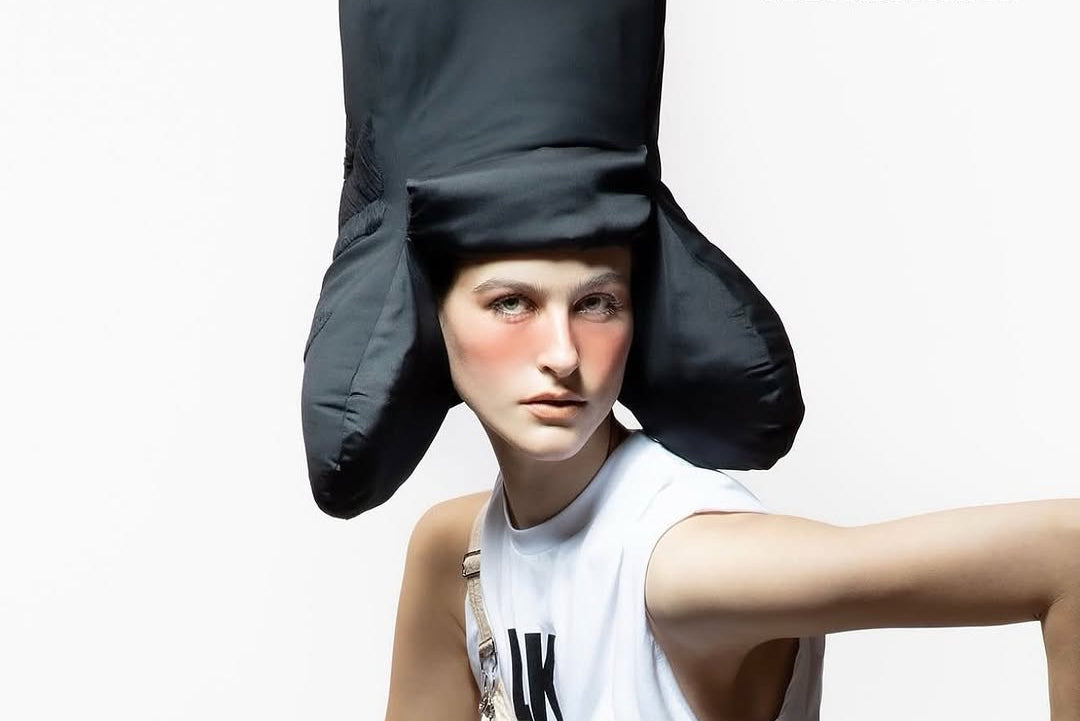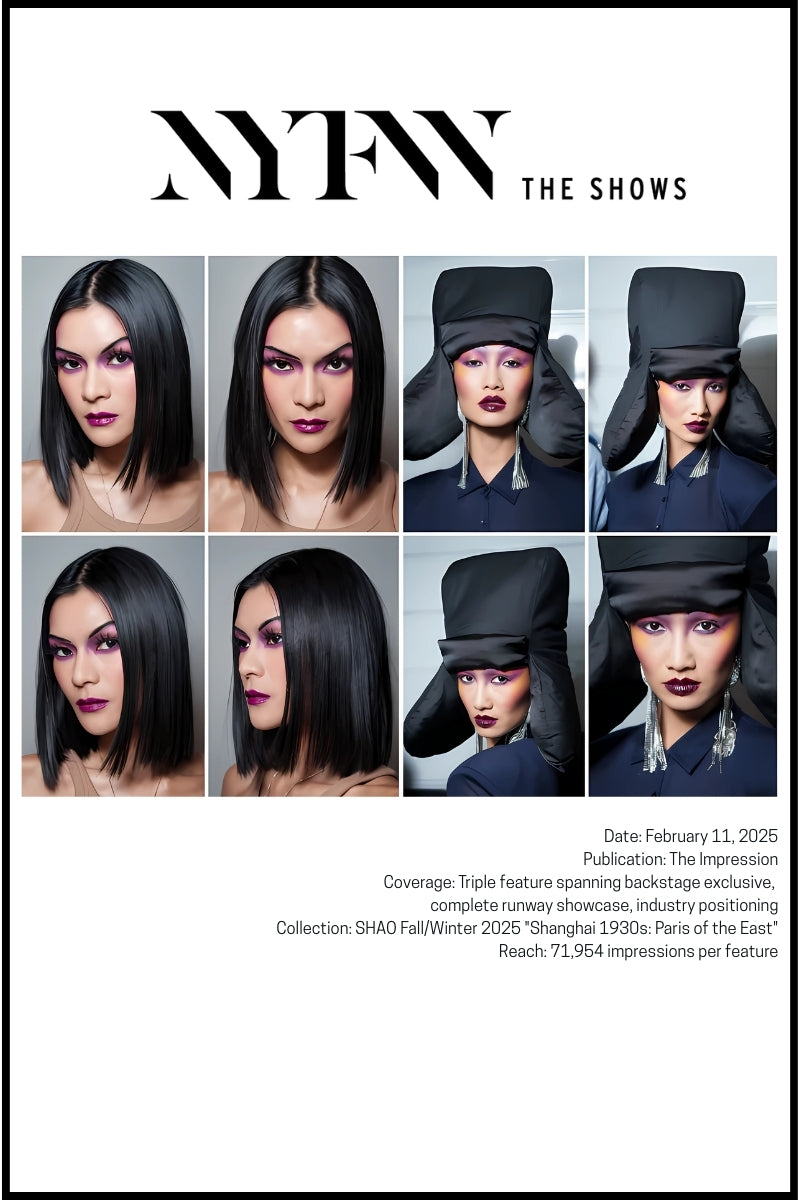Press Showcase: When Heritage Becomes Headline
The WWD coverage of Shao New York's Monday night presentation captures a moment that transcends typical fashion week documentation. At House of the Red Pearl restaurant, designer Shao Yang presented 23 looks exclusively on AAPI models, transforming what could have been another diverse casting story into something more fundamental—a creative decision that emerged from artistic necessity rather than industry pressure.
Yang's emotional response during her finale walk—"I became really emotional. It was very close to my heart and part of my heritage. It was something that I've wanted to do for so long"—reveals the distinction between authentic representation and manufactured inclusion. The Taiwanese-American designer, who moved to Brooklyn at age five and has operated her New York business for a decade, positioned the show titled "1930s Shanghai: Paris of the East, New York of the West" as both historical homage and contemporary statement.
The casting, orchestrated with casting director Michael Eland, created what Yang described as "a little community" backstage, where "everybody was super excited to tell that story." This collaborative energy stands in marked contrast to the often-clinical approach to diversity initiatives that characterize much of contemporary fashion's inclusion efforts.
Yang's candid discussion of discrimination she faces as an Asian woman business owner—"Sometimes when dealing with clients or retail-related issues, there is a xenophobia or discrimination that can happen. That is the world that we live in, and I have personally experienced that"—situates her creative choices within broader cultural tensions. Her pride in working with Chinese artisans despite potential criticism, and her acknowledgment of how post-COVID discrimination brought the AAPI community closer together, frames the runway presentation as both artistic expression and cultural resistance.
Cultural Analysis: The Performance of Authenticity in Fashion's Diversity Theater
The fashion industry's relationship with representation operates like a high-stakes game of cultural telephone, where original intentions often distort into performative gestures by the time they reach mainstream execution. Yang's approach to casting exclusively AAPI models for her show reveals the difference between authentic cultural expression and diversity theater—a distinction that has become increasingly crucial as brands navigate the space between genuine inclusion and market-driven tokenism.
The timing of Yang's decision carries particular weight within fashion's broader reckoning with representation. While many brands have embraced diverse casting as standard practice post-2020, the specific choice to center AAPI models exclusively speaks to a different creative impulse—one that emerges from personal heritage rather than external pressure. This distinction matters because it exposes the often-hollow nature of industry-wide diversity initiatives that treat inclusion as universal solution rather than specific cultural expression.

The show's title, "1930s Shanghai: Paris of the East, New York of the West," establishes a historical framework that connects Yang's contemporary design vision to specific cultural moments and geographic intersections. Shanghai in the 1930s represented a unique convergence of Eastern and Western influences, a cosmopolitan center where traditional Chinese culture met international commerce and modernist aesthetics. By invoking this historical parallel, Yang positions her work within a tradition of cultural synthesis that predates contemporary conversations about East-West fashion fusion.
This historical grounding separates Yang's approach from the surface-level orientalism that often characterizes Western brands' attempts at Asian-inspired design. Rather than appropriating visual elements from Chinese culture, Yang's work emerges from lived experience of cultural navigation—the daily reality of someone who grew up speaking Chinese in Brooklyn while building a business that employs artisans across three continents.
The Economics of Cultural Authenticity
Yang's frank discussion of the business challenges she faces as an Asian woman designer illuminates the economic dimensions of cultural authenticity in fashion. Her acknowledgment of xenophobia in client and retail relationships, combined with her determination to maintain working relationships with Chinese artisans despite potential criticism, reveals how cultural identity intersects with business realities in ways that extend far beyond creative vision.
The designer's reference to Trump administration tariffs and their potential impact on her business operations highlights how geopolitical tensions directly affect individual designers' ability to maintain authentic cultural connections. When working with artisans in China becomes politically loaded, designers like Yang must navigate between cultural integrity and business pragmatism—a tension that rarely surfaces in mainstream fashion coverage but fundamentally shapes how authentic cultural synthesis actually functions in commercial contexts.

This economic reality distinguishes Yang's position from established luxury brands that can afford to treat cultural references as interchangeable aesthetic elements. For a designer whose cultural identity directly informs her creative process, maintaining authentic connections to Chinese craftsmanship traditions becomes both artistic necessity and business risk—a calculation that reveals the privilege embedded in cultural appropriation versus the vulnerability inherent in cultural authenticity.
Street-Level Observations: Brooklyn to Chinatown
Yang's trajectory from Brooklyn childhood to Chinatown runway presentations traces a specifically New York narrative of cultural identity formation. Growing up in Brooklyn while maintaining connections to Chinese heritage through language and family relationships creates a particular kind of cultural fluency—one that emerges from daily code-switching rather than academic study or travel experiences.
The decision to scout Chinatown locations for her September show continuation demonstrates how geographic specificity reinforces cultural authenticity. Chinatown as venue choice carries different weight than a standard fashion week location because it acknowledges the community context that informs Yang's design perspective. This geographic consciousness connects to broader questions about how fashion presentations can honor cultural communities rather than simply extracting aesthetic elements for mainstream consumption.

The backstage community Yang described—models excited to tell the story her collection represents—suggests how authentic cultural representation creates collaborative energy that extends beyond individual creative vision. When models see themselves reflected not just physically but culturally in the work they're presenting, the runway experience transforms from job performance to community expression.
Technical Craft and Cultural Heritage
Yang's emphasis on the craftsmanship she accesses through Chinese artisans reveals how technical excellence and cultural authenticity intersect in ways that challenge fashion's typical East-West manufacturing narratives. Her pride in these working relationships, despite potential criticism, positions Chinese craftsmanship as creative collaboration rather than cost-cutting measure.
The technical aspects of Yang's work—the construction details that emerge from traditional Chinese tailoring techniques applied to contemporary silhouettes—represent a different approach to cultural synthesis than the visual pastiche that often characterizes East-meets-West fashion. When cultural heritage informs construction methodology rather than surface decoration, the resulting garments carry authenticity at a structural level that survives closer examination.
This technical authenticity matters because it distinguishes between cultural inspiration and cultural tourism. Yang's work emerges from understanding construction traditions from within rather than observing aesthetic elements from outside—a difference that manifests in garment details that fashion insiders recognize as genuine rather than performative.
Industry Positioning: Alternative Approaches to Cultural Fusion
Yang's approach to AAPI representation and cultural synthesis offers an alternative model to the corporate diversity initiatives that have dominated fashion's inclusion conversation. Rather than treating diversity as universal standard to be applied across all brands, her work demonstrates how cultural authenticity emerges from specific experience and genuine community connection.
This specificity challenges the fashion industry's tendency to treat cultural representation as interchangeable—the assumption that diverse casting or cultural references can be applied uniformly across different brand contexts. Yang's emotional response to her finale walk reveals how authentic cultural expression carries personal investment that cannot be replicated through policy implementation or market research.
The designer's willingness to discuss discrimination she faces while maintaining pride in her cultural connections models a different approach to navigating industry challenges than the typical corporate crisis management responses. By acknowledging difficult realities while refusing to compromise cultural integrity, Yang demonstrates how authentic representation requires ongoing negotiation rather than one-time solution.
Broader Implications: Fashion's Cultural Reckoning
Yang's runway presentation arrives at a moment when fashion's relationship with cultural authenticity faces increasing scrutiny. The post-COVID rise in anti-Asian discrimination that Yang references has created both increased visibility for AAPI designers and heightened awareness of the vulnerabilities they face in business contexts.
The designer's observation that discrimination brought the AAPI community closer together while they work "really hard together as a group to dispel that behavior and those thoughts" positions her runway choices within broader community organizing efforts. This community context distinguishes authentic cultural representation from individual brand positioning—suggesting how genuine inclusion emerges from collective action rather than isolated corporate initiatives.
Contemporary Relevance: Beyond Fashion Week Theater
The significance of Yang's exclusively AAPI casting extends beyond fashion week coverage because it demonstrates how authentic cultural expression can function within commercial fashion contexts without compromising artistic integrity. Her approach offers a template for how designers can honor cultural heritage while building sustainable businesses—a balance that requires ongoing negotiation rather than simple adherence to industry best practices.
The emotional authenticity Yang brought to her presentation—her visible response during the finale walk—reveals how genuine cultural expression carries personal investment that distinguishes it from performative inclusion. This emotional component cannot be manufactured through casting decisions or marketing strategies, but emerges from lived experience of cultural navigation.
Questions Without Easy Answers
Yang's presentation raises questions about fashion's role in cultural representation that extend beyond individual brand decisions. If authentic cultural synthesis requires lived experience and community connection, how do established brands navigate cultural references without appropriation? When does diverse casting represent genuine inclusion versus market-driven performance?
The designer's frank discussion of business challenges she faces as an Asian woman business owner illuminates how cultural authenticity intersects with economic realities in ways that complicate simple narratives about representation and success. Her determination to maintain relationships with Chinese artisans despite potential criticism demonstrates how authentic cultural connections require ongoing commitment rather than convenient adoption.
The runway community Yang described—models excited to participate in telling her cultural story—suggests possibilities for how fashion presentations can honor communities rather than simply extracting aesthetic elements. But scaling this authentic community connection across industry-wide diversity initiatives presents challenges that individual designers like Yang navigate daily without clear institutional support.
As fashion continues grappling with questions of cultural authenticity and representation, Yang's approach offers evidence that genuine inclusion emerges from specific cultural experience rather than universal application of diversity principles. Whether the industry can distinguish between authentic cultural expression and performative inclusion will determine how effectively fashion can honor the communities it increasingly seeks to represent.
